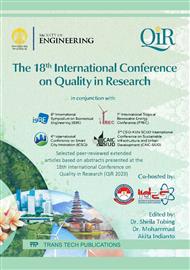[1]
Zheng, T., Wang, X., Lu, C., Zhang, X., Ji, Y., Bai, C., Qiao, Y., Studies on Curing Kinetics and Tensile Properties of Silica-Filled Phenolic Amine/Epoxy Resin Nanocomposite Polymers, Polymers. 11(4) (2019) 680.
DOI: 10.3390/polym11040680
Google Scholar
[2]
D.S. Achilias, M.M. Karabela, E.A. Varkopoulou, and I.D. Sideridou, Cure kinetics study of two epoxy systems with Fourier Transform Infrared Spectroscopy (FTIR) and Differential Scanning Calorimetry (DSC), Journal of Macromolecular Science, Part A: Pure and Applied Chemistry. 49(8) (2012) 630–638.
DOI: 10.1080/10601325.2012.696995
Google Scholar
[3]
Hardis, R., Jessop, J. L. P., Peters, F. E., & Kessler, M. R., Cure kinetics characterization and monitoring of an epoxy resin using DSC, Raman spectroscopy, and DEA, Composites Part A: Applied Science and Manufacturing. 49 (2013) 100–108.
DOI: 10.1016/j.compositesa.2013.01.021
Google Scholar
[4]
S. Liu, X. Li, M. Ge, X. Du, and M. Zou, Curing Kinetics of Methylene Diphenyl Diisocyanate—Based Polyurethane Elastomers, Polymers. 14(17) (2022) 3535.
DOI: 10.3390/polym14173525
Google Scholar
[5]
Kaelble, D. H., & Smith, T., Analysis of curing kinetics in polymer composites, Journal of Polymer Science: Polymer Letters Edition. 12(8) (1974) 473–475.
DOI: 10.1002/pol.1974.130120808
Google Scholar
[6]
Chern, C.-S., & Poehlein, G. W., A kinetic model for curing reactions of epoxides with amines, Polymer Engineering and Science. 27(11) (1987) 788–795.
DOI: 10.1002/pen.760271104
Google Scholar
[7]
Li, H., Wang, H., & Jiao, X., Study on Curing Kinetics of Heat-resistant Flexible Polyamide Modified Epoxy Resin Adhesive, Research Journal of Applied Sciences, Engineering and Technology. 9(12) (2015) 1143–1147.
DOI: 10.19026/rjaset.9.2609
Google Scholar
[8]
Simon, P., Dubaj, T., Cibulkova, Z., Frequent flaws encountered in the manuscripts of kinetic papers, Journal of Thermal Analysis and Calorimetry. 147 (2022) 10083–10088.
DOI: 10.1007/s10973-022-11436-y
Google Scholar
[9]
González, M. G., Cabanelas, J. C., Baselga, J., Applications of FTIR on Epoxy Resins - Identification, Monitoring the Curing Process, Phase Separation and Water Uptake, In: Theophanides, T. (Ed.), Infrared Spectroscopy - Materials Science, Engineering and Technology, InTech, London, 2012, pp.261-284, available at: https://www.intechopen.com/chapters/36178
DOI: 10.5772/36323
Google Scholar
[10]
Li, Q., Li, X., & Meng, Y., Curing of DGEBA epoxy using a phenol-terminated hyperbranched curing agent: Cure kinetics, gelation, and the TTT cure diagram, Thermochimica Acta. 549 (2012) 69–80.
DOI: 10.1016/j.tca.2012.09.012
Google Scholar
[11]
G. Nikolic, S. Zlatkovic, M. Cakic, S. Cakic, C. Lacnjevac, and Z. Rajic, Fast Fourier transform IR characterization of epoxy GY systems crosslinked with aliphatic and cycloaliphatic EH polyamine adducts, Sensors 10(1) (2010) 684–696.
DOI: 10.3390/s100100684
Google Scholar
[12]
D.A. Janzen, M.F. Diniz, J.B. Azevedo, J.R.A. Pinto, N.B. Sanches, and R.D.C.L. Dutra, Qualitative and quantitative evaluation of epoxy systems by Fourier transform infrared spectroscopy and the flexibilizing effect of mercaptans, An Acad Bras Cienc. 93(2) (2021) e20200799.
DOI: 10.1590/0001-3765202120200799
Google Scholar
[13]
J.J.P. Barros, I.D.D.S. Silva, N.G. Jaques, and R.M.R. Wellen, Approaches on the non-isothermal curing kinetics of epoxy/PCL blends, Journal of Materials Research and Technology. 9(6) (2020) 13539–13554.
DOI: 10.1016/j.jmrt.2020.09.081
Google Scholar
[14]
N.G. Jaques, J. William de Lima Souza, M. Popp, J. Kolbe, M.V. Lia Fook, and R.M. Ramos Wellen, Kinetic investigation of eggshell powders as biobased epoxy catalyzer, Compos B Eng. 183 (2020) 107651.
DOI: 10.1016/j.compositesb.2019.107651
Google Scholar
[15]
H. Ma, X. Zhang, F. Ju, and S.B. Tsai, A Study on Curing Kinetics of Nano-Phase Modified Epoxy Resin, Sci Rep. 8(1) (2018) 3045.
DOI: 10.1038/s41598-018-21208-0
Google Scholar
[16]
Standard Test Method for Determination of Kinetic Parameters and Reaction Order for Thermally Unstable Materials by Differential Scanning Calorimetry Using the Kissinger and Farjas Methods, ASTM E2890-21, 2021.
DOI: 10.1520/e2890-12
Google Scholar
[17]
Standard Test Method for Kinetic Parameters for Thermally Unstable Materials Using Differential Scanning Calorimetry and the Flynn/Wall/Ozawa Method, ASTM E698-18, 2018.
DOI: 10.1520/e0698-23
Google Scholar



